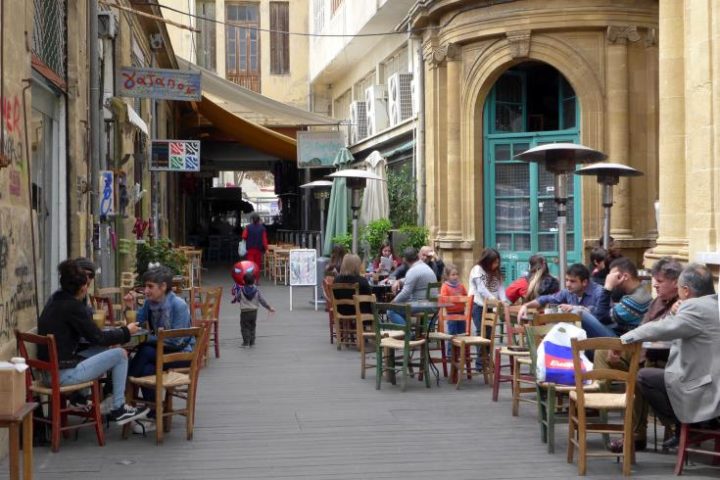* GDP to double by 2035 *
A solution to the longstanding Cyprus problem could raise per capita incomes by approximately EUR 12,000, expand the size of the economy by around EUR 20 bln and add on average 2.8 percentage points to real GDP growth every year for 20 years, according to new research published on Thursday by the PRIO Cyprus Centre. Moreover, these developments would almost eliminate the per-capita income disparity between the two communities, the authors of the study said.
In the past, the tendency has been to see the costs and benefits of a solution in a static way: there was an appreciation of the immediate costs, but there was little understanding of the dynamic benefits.
The Cyprus Peace Dividend Revisited, by Cyprus-based economists Fiona Mullen, Alexander Apostolides and Mustafa Besim, which was funded by the Ministries of Foreign Affairs of Sweden, Denmark, Finland and Norway, takes a fresh look at the likely boost to economic activity as a result of a settlement. The economic impact of peace is considered in two ways: from a top-down approach based on total factor productivity (TFP) and a bottom-up approach based on sector-by-sector forecasts. The final results, which take the geometric mean (an average) of these two independent approaches, incorporate the feedback not only of fellow economists but also of business leaders from both communities who reviewed the preliminary findings during a two-day conference hosted by the PRIO Cyprus Centre in Brussels in March.
The research takes as a working assumption that the settlement comes into force in 2016 (Year 1) and that a united Cyprus will be a based on a bi-communal, bi-zonal federation with political equality as outlined in the February 2014 joint declaration by President Nicos Anastasiades and Turkish Cypriot leader Dervis Eroglu. Documents in the public domain suggest that the two communities have expended considerable efforts during the negotiations to date to avoid the kind of deadlocks that arose in the 1960s. These same documents suggest that attempts will be made to minimise debt-financed property compensation. Thus, the authors’ working assumption is that a united Cyprus will have a functioning system, albeit with new challenges.
Preliminary estimates suggest that this kind of lift to economic activity will bring unemployment in the Greek Cypriot economy down to less than 5% within ten years compared with a rate of well over 10% without a solution.
OVERALL PEACE DIVIDEND
Both economies are currently underperforming in terms of growth in TFP —a measure of the long-term growth prospects for developed economies. Low TFP growth points to a continued future of very weak overall economic growth and high unemployment. Thus, both sides would benefit from a “peace dividend” that will come from two sources: recurring benefits from opening up the Turkish market of 74 mln people to Greek Cypriots and the European Union market of 500 mln people to Turkish Cypriots, and settlement-specific investment.
• All-island GDP at constant 2012 prices would rise from just under €20 bln in 2016 (Year 1) to just under €45 bln by 2035 (Year 20) compared with around €25 bln without a solution. In other words, the peace dividend over 20 years would be approximately €20 bln.
• The annual average peace dividend would be just over €2 bln in the first five years after a solution, just under €5 bln in the first ten years and just over €10 bln the first 20 years.
• GDP per capita would rise from around €15,500 in 2016 to around €28,500 in 2035, compared with approximately €16,500 without a solution. Thus, annual incomes, at constant 2012 prices, would be around €12,000 higher by Year 20 with a solution than without one.
• The annual average growth rate would be 4.5% over 20 years, compared with just 1.6% without a solution, with the peak growth rates coming in the first ten years. The lift to real GDP growth rates would therefore be around 2.8 percentage points on average each year.
• Per-capita incomes in the TCC would be 91% of GCC incomes in 20 years (that is, not far from full convergence), compared with around 60% of GCC incomes today.
PEACE DIVIDEND BY SECTOR
• Tourism: A settlement of the Cyprus problem would attract new tourists to holy sites and ancient sites throughout the island, such as the Hala Sultan Tekke mosque in Larnaca and the church and monastery of St Barnabas in Famagusta, or the ancient ruins of Kourion near Limassol and Salamis near Famagusta. Value-added in the tourism sector would rise from €1.3 bln in 2012 to €2.9 bln in 20 years (2016-2035), with additional income-creation of approximately €550 mln a year.
• Construction: Construction and real estate can expect a boom as a result of settlement-specific investments that will significantly alleviate the problems faced by banks. In a no-solution scenario, construction in the economy of the Greek Cypriot community is expected to continue shrinking in 2014-15 after a 30% decline in 2012. It would recover to only €730 mln at constant prices compared with just over €1 bln in 2012. However, in a united Cyprus this sector would expand much faster, reaching €2.1 bln in 2035 and yielding an annual average peace dividend of €725 mln for both communities.
• Wholesale and retail trade: This sector stands to gain the most from a solution as the expansion of tourism and construction will create spillover effects rising from €2 bln in 2012 to €5 bln in constant prices in 20 years, compared with only €2.8 bln without a solution.
• Transport: Shipping and cruise tourism would be free from current constraints, while the exploitation of natural gas and potentially oil will create new opportunities. At the same time new flight connections will allow Cyprus to become the regional hub it has always sought to be. Transport would increase from just under €900 mln in 2012 to €2.3 bln in 2035.
• Financial and professional services: With new connections, Cyprus would become a true business nexus centred on the professional services sector, especially if a solution is accompanied by double taxation and bilateral investment treaties with Turkey. Financial services would grow from €1.7 bln in 2012 to €2.7 bln in 2035, with an annual average peace dividend of €380 mln, while professional services would increase from €1.3 bln to €3.7 bln and enjoy an annual average peace dividend of just over €1 bln.
• Higher education: Peace would allow the established universities on the island to create a single united Cyprus brand that would have a chance of becoming one of the most important educational centres in the region. This sector has significant potential and the authors estimate that the total size of the sector will grow from €1.3 bln in 2012 to €2.4 bln in 20 years, yielding an annual average peace dividend of just under €270 mln in constant prices.
GAS, HOUSING AND FAMAGUSTA
Natural gas: A solution could allow the construction of an energy pipeline to Turkey. This would be possible even with today’s level of gas volumes, which is currently not the case for a liquefied natural gas plant (LNG) or a pipeline to Greece. It should be noted that a pipeline to Turkey would be in addition to and not instead of an LNG plant, which would remain a desirable goal. A pipeline to Turkey would generate €1.3 bln in additional gross investment. More importantly, it would yield much earlier government gas revenues than would be the case without a solution.
Famagusta: Rejuvenating Famagusta, including Varosha and the port, could generate, in a low-investment scenario, €5 bln. However, sector specialists informed the authors that a big-vision idea, such as a state-of-the art eco-city that integrated the whole of Famagusta, could generate investment of up to €15 bln. Whichever option is chosen, it would need to be done primarily with private-sector investment.
New housing: A solution would create demand for new housing, which the authors estimate would generate gross investment of €2 bln.
Total settlement-related investment: In total, investment in infrastructure and housing that is specifically related to the settlement could reach €10 bln. It is important to note that €10bn of construction investment is not the same a value-added recorded for national accounts and GDP purposes. Thus, €10 bln of mainly construction investment would lead to value-added ranging from roughly €4 bln to €5bln. It would therefore account for between one-fifth and one-quarter of the peace dividend.







